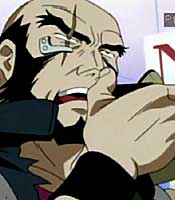by Sara Ellis and Luis Reyes
|
The back half of the twentieth century, the age of analysis and introspection, found artists, sociologists and scientists
deconstructing style, form and content so as to make genre an elusive concept. And here, at the doorstep of the twenty-first
century, we have their love child - "Cowboy Bebop," the show that becomes a genre itself.
"The world of 'Cowboy Bebop' is an underworld," says series producer Masahiko Minami at Bones, a splinter company of
Sunrise, Inc., which bankrolled the title along with Bandai Visual. "It's a world in which either people collect bounties or
they have a price on their heads. It's a world in which countries, different societies and races have become completely mixed."
Blues and swing merged to form rock; a classical ethos merged with a blossoming humanism to become the Renaissance; pulp
fiction merged with cinema to become film noir. "Cowboy Bebop" is at the evolutionary crossroads of pop-culture and high art
and by being so it deserves to be called its own genre. But this show achieves this while at the same time disregarding the
kind of analytical deconstruction that opens this article. So, in fact, "Cowboy Bebop" not only transcends genre, it transcends
traditional analysis - and in being so baffling, it becomes so human, and that is perhaps why it is so appealing; fascinatingly
directionless people caught up in fascinatingly directionless stories for a post-post-modern time of fascinating
directionlessness.
"'Cowboy Bebop' reflects the era," Minami continues. "Director Shinichiro Watanabe was interested in a series in which the
characters meet and part. Human beings are always in one way or another saying 'hello' and 'goodbye.' At the center of all this
meeting and parting is the self, the individual. So by using the scenario structure of meeting and parting we can better express
individual characters such as Faye, Spike, Jet, Ed and even Ein."
Faye Valentine, an iconic Femme Fatale seductress, cocky to a fault, gracelessly scarfs down dog food, which she, out of
desperation, steals from an emaciated Ein. Her rootlessness and yearning to discover her past sets her on a quest she has no
way of completing.
Spike Spiegel, a bounty hunter capable of taking down seven thugs in the street and escaping torrents of bullets with nary
a scrape, can't seem to score a single substantial bounty. And the past that haunts him doesn't catch up with him more than he
dives back into it, head first and blinded by love.
Jet Black, a strong, formidable leader that can't get his rabble to do anything he asks, a fault indicative of why he drove
away the woman he loved and was ejected from the policing organization he served. A good man in a bad world.
"Spike and Jet are actually very old style characters like the world of old Enka [Enka is a popular form of music that draws
its roots from the latter 19th century when folk singers would sing protest songs against the authoritarian government. Nowadays,
Enka music is usually romantic and sad in nature, a lugubrious and melodramatic style akin to bluesy American country music.] -
the kind of men who don't live very skillfully, men who cannot resist their own souls, who do whatever they want to do. Faye is
also an old-fashioned character type. She does what she wants. We basically mixed old-fashioned characters with a new visual
expression. Ed is probably the only new type of character."
|


